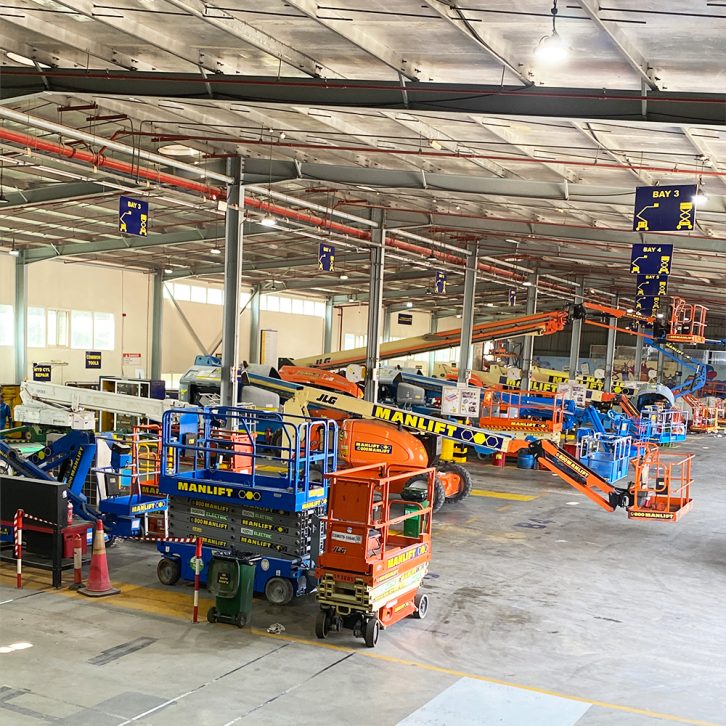Planning and preparation are the first steps to begin with when it comes to safe working at height: Minimise the risk of incidents and accidents – improve worker safety while investing in the right procedures before anyone leaves the ground. This two-part journal outlines the approach during the planning process captured by Manlift’s leading safety experts – Wim van Meer and Robert Cavaleri.
At all work sites potential risks and hazards need to be identified and addressed before anyone use a Mobile Elevating Work Platform (MEWP), such as boom lifts or scissor lifts. A thorough risk assessment should cover the following key areas:
- Site survey and risk assessment
- Selecting the correct MEWP
- Pre-use inspections
- Personal protective equipment (PPE) selection
- Last-minute checks
Site Survey and Risk Assessment
The site survey and risk assessment must be carried out by someone who has acquired the appropriate training and experience and is also known as a Competent Person in legal terms. Manlift can advise you on which risks to bear, but it is essential that your Competent Person performs the risk assessment.
You have a legal and moral obligation to carry out a comprehensive site risk assessment. This results in identifying and addressing potential risks to employees, colleagues, and other contractors working in the same area. It also implies to identify potential hazards and the level of risk for each hazard. A risk assessment must be specifically tailored to each site and application – you cannot adopt a “one size fits all” approach.
Key steps in a Risk Assessment are:
- Identify hazards – anything that could cause harm
- Decide who might be harmed, and how that could happen
- Assess the risks and take the right precautions
- Make a record of your findings
- Regularly review the risk assessment and update it as required
Potential risks to consider include:
- Shallow pits and holes – including those hidden by water, ice, mud, and debris
- Ledges, slopes, and rough terrain
- Potholes, drains, manholes, trenches, and other excavations
- Ground-level obstructions such as boulders, bollards, and debris
- Overhead obstructions, crushing/trapping hazards, and electrical conductors
- Hazardous locations and atmospheres
- Ground or floor load-bearing capabilities
- Wind and weather conditions
- Presence of unauthorized persons
- Potential collisions with other machinery
One of the biggest challenges for MEWPs is while the machine is elevated. Here it is important during the risk assessment to ensure that you have an emergency rescue plan which includes having people on the ground, working nearby, who are trained in using the ground controls and the emergency lowering system.
Moreover, to help prevent operators being crushed by an overhead obstacle many boom lifts and scissor lifts are now fitted with secondary guarding devices. There are differences in how these devices work which makes it even more important to gain an understanding of anti-entrapment which forms a critical part of your risk assessment when it comes to identifying any hazards from overhead objects.
In particular on construction sites, the environment is constantly changing. So be prepared to update your risk assessment as the situation develops – for example, as additional contractors or construction equipment begins working in the same area as your MEWP.
Selection of the correct MEWP for Safe Working at Height
Both, the site survey and risk assessment will enable to selection of the most appropriate MEWP for safe and efficient working at height. Some of the key considerations are:
- What is the intended task?
- Will the platform be working indoors, outdoors, or both?
- What platform capacity and size do you require?
- How many occupants will be in the basket or platform?
- What working height and outreach do you require?
- What are the ground or floor surface conditions?
- Do the operators have the right training and qualifications?
- Are there any obstacles on the ground and at height?
- What are the MEWP maintenance requirements?
- Are noise pollution or exhaust emissions an issue?
The key benefits of selecting the optimum aerial lift are:
- Ensure operator and occupant safety
- Ensure the safety of other workers on site
- Complete the task in the most efficient manner
- Reduce work stress for the operator
- Reduce the likelihood of equipment damage
- Reduce the likelihood of property damage
For advice on Pre-use inspections, selecting the right PPE, and carrying out last-minute checks, please read Part Two of our blog.
